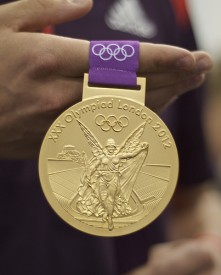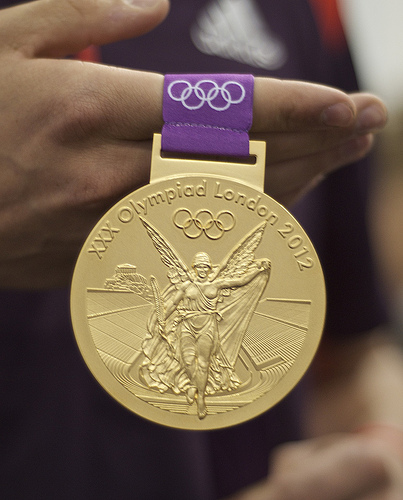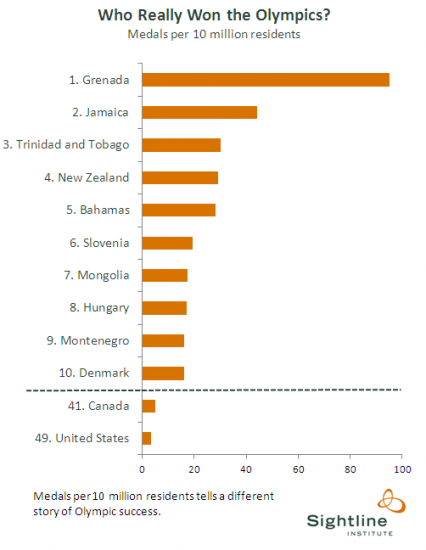
The closing ceremony is over, the medals have all been awarded…but there’s still time to argue over Olympic glory. And since there are no more actual athletic competitions to judge, the only thing that we geeks have to argue about is the numbers.
By some measures, the US was the standout performer of the 2012 summer Olympics. With more golds, more silvers, and more total medals than any other nation, it sure looks like the US has a lock on the gold medal for most athletic country, right?
Not so fast. Sure, the US got a lot of medals. But there are also an awful lot of us: we’re the third most populous nation in the world, trailing only China and India. We’re also a wealthy nation—and as New York Times blogger Nate Silver convincingly argues here, wealthy nations have an Olympic-sized advantage in racking up medals. So, naturally, you’d expect a wealthy nation with lots and lots of residents to earn a lot of medals.
So after adjusting for population, how did the US do in the Olympics? Gauged by medals per capita, our performance was nowhere near medal-worthy. Among the 85 nations that received at least one medal, the US ranked 28th in the number of gold medals per capita, and a lowly 49th in total medals per capita. In a word…meh.
Interestingly, the three standouts in the medals-per-capita race were all Caribbean nations that specialize in track and field. Tiny Grenada netted just one medal—Kirani James‘s gold in the men’s 400m. Yet with a population of just 105,000, James’s performance earned Grenada far and away the most golds per capita, and also the most total medals per capita.
Coming in at silver in medals per capita was Jamaica. Usain Bolt got the headlines, but their entire short-distance track team was dominating, garnering 12 medals—including 4 of each flavor—from a national population of about 2.7 million. (That’s less than one one-hundredth of the size of the US.)
Nabbing the bronze in the per-capita medal race was Trinidad and Tobago, with 4 medals—a gold in the javelin and 3 third-place finishes in other track events—out of a population of 1.3 million. All three of the top per-capita medal earning nations have less economic output per capita than the US—which pushes them even farther ahead in the adjusted medal-winning rankings.
After the jump, the top 20 finishers in the medals per capita race:
| Rank | Nation | Medals per 10 million residents |
| 1 | Grenada | 95.2 |
| 2 | Jamaica | 44.3 |
| 3 | Trinidad and Tobago | 30.4 |
| 4 | New Zealand | 29.3 |
| 5 | Bahamas | 28.3 |
| 6 | Slovenia | 19.4 |
| 7 | Mongolia | 17.6 |
| 8 | Hungary | 17.1 |
| 9 | Montenegro | 16.1 |
| 10 | Denmark | 16.1 |
| 11 | Lithuania | 15.7 |
| 12 | Georgia | 15.6 |
| 13 | Estonia | 15.5 |
| 14 | Australia | 15.4 |
| 15 | Croatia | 14.0 |
| 16 | Belarus | 13.7 |
| 17 | Cuba | 12.4 |
| 18 | Netherlands | 11.9 |
| 19 | Cyprus | 11.9 |
| 20 | Qatar | 11.8 |
There’s perhaps some slim consolation for the US: China came in 2nd in the race for total medals; but adjusting for population pushes them all the way down to 74th place, even lower than the US. So perhaps the real lesson here is: if you want to win a medals-per-capita competition, your best strategy is to be a small country…and hope you’ve got a few people who can run really, really fast.
So what’s all this Olympic bean-counting doing on a sustainability blog? I thought it was a good illustration of a bigger principle: sometimes, to figure out how you’re really doing, you have to do the math. And when you turn performance measures on their side, a standout performance can seem ho-hum, and a mediocre performance can seem stellar. And on issue after issue, that’s exactly what our Cascadia Scorecard finds: places that lead the northwest on key sustainability indicators are often trailing far behind the globe’s real leaders. But that’s a story that you can only discover by actually exploring the data.
Update 3:55: We’ve made this into a chart, too!



Comments are closed.